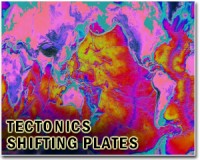| . |  |
. |
Sydney (AFP) April 13, 2011 Scientists have for the first time shown a link between intensifying climate events and tectonic plate movement in findings that could provide a valuable insight into why huge tremors occur. Understanding why plates change direction and speed is key to unlocking huge seismic events such as last month's Japan earthquake, which shifted the Earth's axis by several inches, or February's New Zealand quake. An Australian-led team of researchers from France and Germany found that the strengthening Indian monsoon had accelerated movement of the Indian plate over the past 10 million years by a factor of about 20 percent. Lead researcher Giampiero Iaffaldano said Wednesday that although scientists have long known that tectonic movements influence climate by creating new mountains and sea trenches, his study was the first to show the reverse. "The closure or opening of new ocean basins or the build of large mountain bands like the Andes or Tibet itself, those are geological processes that affect the pattern of climate," said Iaffaldano, an earth scientist with the Australian National University. "We are showing for the first time that the opposite also is true, that the pattern of climate is then able to affect back in a feedback mechanism the motion of tectonic plates." Iaffaldano stressed that his study did not mean that global warming would translate to stronger earthquakes happening more often, with the relevant patterns developing over "the order of millions of years." "Of course earthquakes do occur at the boundaries between plates because of plate motions, but our work doesn't imply at all that we will see an increase in these types of events," he told AFP. Iaffaldano collaborated with Universite de Rennes geoscientist Laurent Husson and Hans-Peter Bunge from Munich's LMU university on the study, which was recently published in the Earth and Planetary Science Letters journal. The team plans to build on the study by probing whether climate events have had a similar impact in other regions. "For example I can imagine that there might be a signature of climate in the Andes for example or in the Rocky Mountains," said Iaffaldano. "This is something that we should look at in the future."
Share This Article With Planet Earth
Related Links Tectonic Science and News
 Scientists describe 'yo-yo' Earth movement
Scientists describe 'yo-yo' Earth movementCanberra, Australia (UPI) Apr 11, 2011 Australian researchers, with European colleagues, have confirmed a formerly purely theoretical geologic phenomenon and have given it a name - yo-yo subduction. The conventional view of subduction - in which Earth's crust is pushed down into the planet's interior in the convergence of tectonic plates - is that it happens only once and in one direction, Daniela Rubatto at the Australia ... read more |
|
| The content herein, unless otherwise known to be public domain, are Copyright 1995-2010 - SpaceDaily. AFP and UPI Wire Stories are copyright Agence France-Presse and United Press International. ESA Portal Reports are copyright European Space Agency. All NASA sourced material is public domain. Additional copyrights may apply in whole or part to other bona fide parties. Advertising does not imply endorsement,agreement or approval of any opinions, statements or information provided by SpaceDaily on any Web page published or hosted by SpaceDaily. Privacy Statement |